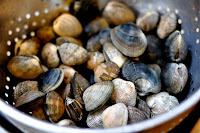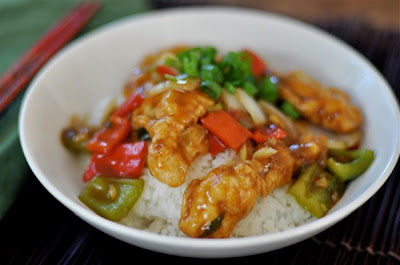Last week I shucked and jived with my first shellfish class. We couldn’t have asked for a better day. The sun was out, as were bald eagles, plenty other clam diggers, and daytrippers shaking off what has been a tough spring of record rain and cold. A herd of elk even joined us on the beach to take in the sun. John Adams, manager of Taylor Shellfish‘s Dosewallips farm, was also on hand to share his extensive knowledge of shellfish habits and habitat.
And my words of wisdom to the assembled students, as reported by Seattle Weekly‘s new food critic, Hanna Raskin? Shellfish harvesting is “embarrassingly easy.” Not that you should be embarrassed to take a class to learn how! Probably my choice of words could have been better.
The thing is, digging Manila clams is easy. They live just a few swipes of a hand rake beneath the surface of gravelly or muddy beaches throughout Puget Sound. After digging limits of clams and picking oysters, we walked back to a picnic shelter at Dosewallips State Park to cook our catch. If clamming is embarrassingly easy, preparing a gourmet meal in the outdoors is eye-poppingly simple.
First, to accompany an oyster shucking demo, we whipped together a Tom Douglas mignonette with champagne vinegar, diced shallot, lemon zest, and black pepper. I keep baby jars on hand for just this purpose. The mignonette was met with unanimous approval—it’s no secret that a touch of acidity can bolster the joys of oyster eating.
Next we fired up the camp-stoves to make two different batches of steamed clams, one with Italian sausage and tomato, the other with a white wine and herbed butter sauce. I put the students to work. They diced onions, minced garlic, browned sausage, chopped herbs, and so on. The beauty of steamed clams is that a little prep leads to a meal that tastes like hours of kitchen slaving. The clams’ liquor is the magic ingredient, combining with the other elements to create an alchemy of flavors that demands good crusty bread for full sopping effect. Empty beer boxes soon filled up with shells, a modern day midden.
Meanwhile John put the charcoal grill to work. He had a bag of key limes on hand for just this moment. I can now say that BBQ oysters with a squeeze of key lime is my new favorite way to eat the briny bivalves. I’ll probably always like raw oysters the most, but it had been a while since I’d last barbecued them—and with a squirt of hot sauce rather than lime. John’s method was an improvement. Oysters plump up nicely on the grill and the flavor is more rich than raw on the halfshell. The key lime was a perfect accompaniment. John said his father—also a shellfish farmer—believed that oysters with barnacles on the shell were superior to those without. I had to agree.
The next night I prepared the rest of my clam limit at home, using this basic but flavorful Thai preparation.
Spicy Thai Basil Clams
3 lbs Manila clams
1 tbsp peanut oil
6 cloves garlic, diced
1 thumb ginger, diced
8 Thai bird chilies, halved & de-seeded
2 tbsp Chinese rice wine
2 tsp sugar
1 tbsp fish sauce
1 tbsp chili bean sauce
1 1/2 cup basil, chopped
1. Scrub and rinse clams.
2. Combine rice wine, sugar, fish sauce, and chili bean sauce into small bowl.
3. Heat oil in wok. Stir-fry garlic, ginger, and chili peppers for a minute or two over medium heat, then stir in sauce, raise heat to high, and add clams. Cover and cook until clams open, several minutes.
4. When clams have opened, remove from heat and stir in basil.
Serve immediately with steamed rice while singing Johnny Cash’s “Ring of Fire” as fair warning to your guests.






































